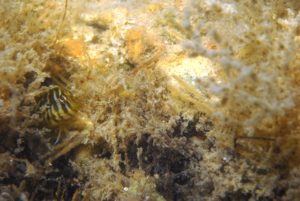When I recently snorkelled at the Ship’s Graveyard in the North Arm of the Port River, I saw lots of blennies disappearing into holes on the river bed. They were much too quick for me to be able to identify them at all. Some of them seemed to have long-flowing eel-like tails. I struck it lucky when I returned back to shore and a blenny posed on a rock for me. I was quite surprised by the colour, shape and size of the blenny. It was unlike anything that I could recall ever seeing before. This was my first shot of the blenny: –
I was able to take a quick photo of it before moving in a little closer for a close-up shot. This was my second, closer shot of it: –
Later that day, I shared my photos with David Muirhead in order to identify the blenny. He quickly identified it as a male Oyster Blenny. I had to search online at first for any details regarding oyster blennies. I had to search through several of my fish books to find a photo of one for comparison. The scientific name for the Oyster Blenny is Omobranchus anolius. I finally found a photo of one on page 336 of “Coastal Fishes of South-eastern Australia” by Rudie H. Kuiter. The same photo can also be found in Rudie’s fish encyclopaedia “World Atlas of Marine Fishes”.
David later provided me with some details, as follows: –
“Male adult oyster blenny which I’d not seen at all, or maybe rare glimpses, not any chance to get photos all my diving life till they started becoming, or appeared to be, getting more common anyway, from when I saw my first definitely identified and photographed specimens very approximately 1-2 decades ago. I’ve now seen heaps of them, always in shallow water usually intertidal.
From memory, my most frequent sightings are for Whyalla north marina (?Point Lowly marina more accurate ), Marino Rocks (and even Brighton & Seacliff ), and less frequently, but certainly further south towards Normanville, possibly including Lady Bay, but certainly Carrickalinga at Haycock Point.
I’ve browsed books and Mark McGrouther posted several of my images several years ago. When I first started seeing them, I was excited, thinking perhaps feral e.g. via shipping from Sydney area, but apparently they’ve been known to occur here in SA for some time, even possibly a long, long time.
Shipping
But I’m still suspicious that they could either be a recent arrival here in SA e.g. feral or more likely via global warming (and just possibly they’ve also been assisted in establishing here in the lower energy parts of our two main gulfs by marinas being constructed which seem to be their favourite habitat -the marina near Whyalla was crawling with them right where the launch ramps are. .. which are cement structures and I saw as many oyster blennies there as Tasmanian blennies when I went to False Bay around 2013.
The other thing is that in eastern Australia the name oyster blenny derives from their habit of hiding in empty Pacific and Sydney rock oyster shells. So we set their arrival up perfectly by establishing all the oyster leases here in SA!
I’m very suspicious that the species was either:
rare or even just an occasional vagrant to explain any early records for SA ,
or
never occurred naturally here until recently e.g. last few decades
and
if so, it’s got established here with human help (as above i.e. warmer water/marinas/coastal shipping /oyster leases /etc.. “
David later sent me the following images of previous Oyster blenny sightings by him: –
Female Oyster Blenny, marina ramp at dusk, north of Whyalla
Female Oyster Blenny at dusk (snorkel at marina at Whyalla C.Feb 2013)
Male Oyster Blenny (snorkel at Port Broughton jetty 21-03-14)








Interesting to note a similar experience with Oyster Blennies. I have seen many darting around whilst snorkelling and diving the top of Spencer Gulf, but never saw one long enough to ID or photograph, then recently got some pics and ID’d them as Oyster Blennies. I’ve since found lots of them in and around the timber work of the “old vehicle bridge” at Port Augusta.
Thanks for reporting your sighting experiences to us Jeff
Thanks for sharing your recent observations from the Port River estuary, Steve.. I hope they encourage others to explore there as we have.